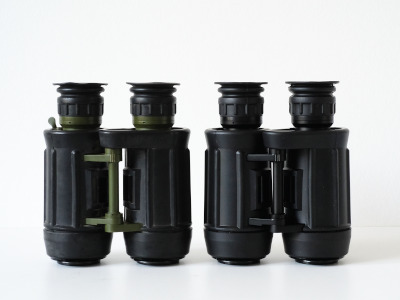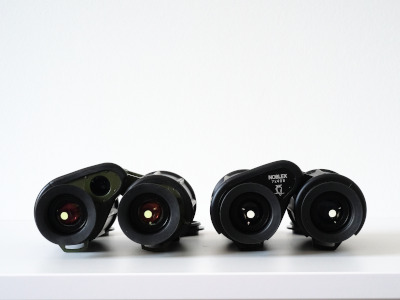

After the production of binoculars by Carl Zeiss Jena had ceased at the beginning of the 1990s, it was Docter Optics which took over the binocular production plant in Eisfeld. Gradually, an increasing number of the original models were discontinued and partly replaced with binoculars of Japanese origin. Meanwhile, Docter has been taken over by Noblex and among the very few surviving models of the Zeiss Jena era are the 7x40 B/GA and the 10x42 B/GA. The 7x40 B/GA is the direct decendant of the EDF, the field binocular used by the East German Peoples Army (NVA) during the 1980s. With just a handful of modifications implemented since then, the 7x40 B/GA looks and feels like the original military gadget. It is therefore interesting to go into details and check out how precisely these two binoculars perform in a side by side comparison.
Fig. 1: The original Carl Zeiss Jena 7x40 EDF (made in 1987) next to the current Noblex 7x40 B/GA
Fig. 2: The lever (left) to switch on/off the reticle illumination of the EDF
Fig. 3: Coatings: The Noblex B/GA shows a rather bright reflection on its front lenses (right)
Fig. 4: Color fidelity (left, Noblex up) and reticle of the EDF (right)
Some of the military features that were implemented into the EDF have been removed, including the reticle to estimate distances, the radioactive (Tritium based) reticle illumination, and the detector that was once used to identify infrared spotlights during the night. Another modification which is immediately visible is the absence of the strong yellow image color, present with the original EDF as a result of (radiation-resistant) SF3R-glass. That strongly colored flint glass is meanwhile replaced with a neutral optical glass of otherwise identical properties, so that the optical layout of the Noblex 7x40 B/GA does not differ visibly from the original CZJ design. Apart from the change of optical glass, the lens coatings are modified and generally improved a lot. Despite of that, I have spotted a single intense reflection on the objective lens of the Noblex B/GA which was far less visible with the EDF (Fig. 3). I can only speculate whether this reflection might be the result of an isolated lens surface being left uncoated or - at least - being coated with a less efficient anti reflection layer. Since that feature appears on both objective lenses, it seems unlikely to be the result of an oversight that happened accidentally with a single lens only.
The following table summarizes the almost identical specifications of the two contenders.
| Real angle | Apparent angle | Field of view | Eye relief | Exit pupil | Close focus(*) | Waterproof | Weight(**) | |
| of view (deg) | of view (deg) | (m/1000m) | (mm) | diam. (mm) | (m) | (gram) | ||
| CZJ EDF 7x40 | 7.5 | 53 | 131 | 20 | 5.7 | 5 | Yes | 890 |
| Noblex 7x40 B/GA | 7.5 | 53 | 131 | 20 | 5.7 | 5 | Yes | 895 |
(*) Estimated; (**) without straps and eyepiece cover
Angle of view: With 131m/1000m, these binoculars are by no means wide angle instruments. Yet, the impression through the eyepiece is not that of a narrow tunnel view, since these binoculars feature a rather high degree of pincushion distortion which somewhat expands the apparent angle of view.
Image sharpness: Despite of the absence of P-coatings in their roof-prisms, images appear perfectly sharp in their central region. Towards the edge of field, a significant field curvature leads to defocussed star images for observers with a reduced ability to accommodate. When I tested the EDF in 2004, I reported about my observation that star images remained point-like within 80% of the viewing angle (from center towards the edge of field), but today, 16 years on and now being above 50 years of age, I hardly see point-like stars 70% out. The EDF was a military binocular and predominantly used by young soldiers with wide accommodation ranges, who would have little difficulty using almost the entire field of view, but for elder observers the field curvature is becoming an obstacle. I do not see any differences between the EDF and the Noblex B/GA in this comparison.
Image color: The EDF came with a spectacular yellow image tone which was useful to dim down intense daylight, but also in situations of hazy weather, in which the yellow color tint helped to increase the contrast. It is of use over snow fields or water, too, when strong reflections of sunlight are blinding the views. The Noblex B/GA has almost neutral colors, apart from a very slight warm tone. No doubt the Noblex version offers an increase of overall versatility with its neutral image tone, including a brighter image in low light situations.
Rectilinear distortion: These binoculars display a rather high amount of pincushion distortion that is rarely seen with binoculars of recent production dates.
Fig. 5: In front of the prism entrance, the EDF features a black stray light shield (left), which is absent with the noblex (right)
Stray light: While both binoculars perform well in daylight, I have noticed that the Noblex B/GA tends to generate a diffuse stray light under twilight conditions. When pointing a flashlight through its objectiv lenses into the tube, then the usual stray light baffles are visible, but beyond those baffles, close to the prism, there exist openly visible metallic structures which, to the contrary, were perfectly shielded against incoming light inside the EDF. I suspect that the omission of that stray light shield may be related to the B/GA's proneness to generate diffuse reflections which reduce somewhat its contrast under low light conditions. In this regard, the B/GA does not quite share the excellent stray light resistance that the EDF is well known for.
Ghost images: If, at night, a bright object (street lantern, moon) is positioned into the field, reflections on the air-to-glass surfaces take place, which can lead to multiple 'ghost' images of the light source. A successful suppression of these ghosts indicates a high quality of the anti-reflection coating. Both binoculars are performing well here, although the EDF does show a reflex on its reticle which remains absent with the B/GA. More annoying are the pronounced spikes produced at the roof edges of these binoculars. They arise as a result of diffraction at that roof edge and also show up whenever the phase-correction coating (P-coating) of the roof prism is absent or of insufficient quality. The EDF was produced before the introduction of P-coating (in 1988), but the Noblex B/GA is nowadays still made without such a coating. The resulting spikes at bright pointlike light sources appear even a little brighter with the B/GA than with the EDF, but I suspect that this must be the consequence of an overall brighter image of the B/GA.
Chromatic aberration (CA): No big issue with any of these binoculars. Although I see a hint of color fringes on edges of objects located in the outer image areas, those aren't particularly prominent. Firstly, the fields of view are just moderate and these fringes usually turn annoying with binoculars of wider fields, and secondly the field edges are somewhat blured as a result of field curvature, so that these color fringes are blured as well and thereby losing intensity.
Low light performance: It is quite obvious that the B/GA shows a brighter image in low light when compared to the EDF. Both, the improved transmission of short wavelengths due to the change of optical glasses, as well as the meanwhile generally improved coatings contribute to a visibly higher transmission of the Noblex B/GA.
Mechanical robustness: Appears to be identical with both candidates. It is reasonable to assume that the mechanical construction, which is responsible for the outstanding ruggedness of the military-grade EDF, has not changed since the 1990s and that the Noblex B/GA is most likely of the same robust construction as its predecessor. These binoculars are fully waterproof and exhibit an extraordinary resistance against mechanical impact due to their though rubber armors and massive frames.
Usage/features: These aren't luxury items. Focus is achieved with a rather inconvenient individual eyepiece focus mechanism, the close focus distance is rather far out at roughly 5m, and eye-cups are soft telescopic rubber tubes which are simply pressed down until distance fits. On the other hand, Eye-relief is very generous with at least 20mm, and these binoculars remain usable with any imaginable types of spectacles or even gas masks. They are very heavy, close to 900g, but protected by a thick and very tough rubber armor that resembles car tyres rather than the usual rubber skin. That armor can be removed when the binocular has to be cleaned. The soft eye-cups are efficiently shielding the eye from light that might enter from the sides and thus guarantee a maximum contrast even in brightest sunlight. I found the mechanics of the Noblex B/GA to be very stiff, too stiff in fact, but that may soften over time after the binocular has gone through some months of usage.
| Angle of | Image (edge-) | Stray | Ghost | Color | Color | Low | Usage/ | Mechanical | Final | |
| view | sharpness | light | image | fringing | fidelity | light | features | robustness | score | |
| Noblex 7x40 B/GA | 1.5 | 1.5 | 1 | 1.5 | 1.5 | 2 | 2 | 1.5 | 1.5 | 14 |
| CZJ 7x40 EDF | 1.5 | 1.5 | 2 | 1.5 | 1.5 | 1 | 1 | 1.5 | 1.5 | 13 |
The 'final score' is the sum of the individual scores and is intended to serve as an orientation only.
During the last 30 years since the original EDF has been discontinued, its successor, the Noblex 7x40 B/GA, has undergone only minor modifications, including the choice of optical flint glass and coatings. These changes have led to vastly improved color fidelity and an increase of transmission. A step backwards is the currently observable tendency to develop diffuse stray light after sunset - possibly related to a missing stray light shield which originally sat close to the prisms. Mechanical properties of the Noblex B/GA can be assumed to be of similar robustness as with the EDF, because construction details appear unchanged. On the part of the manufacturer, it would be advisable to pay more attention to the sets of prisms of the B/GA, since those are still left without any P-coating which is nowadays so common with roof-prism binoculars of reasonable quality. Nevertheless, the Noblex 7x40 B/GA is still an extraordinary, if not excentric piece of gadget that is close to being indestructable and certainly reliable under any environmental condition.
Last modified: July 2020